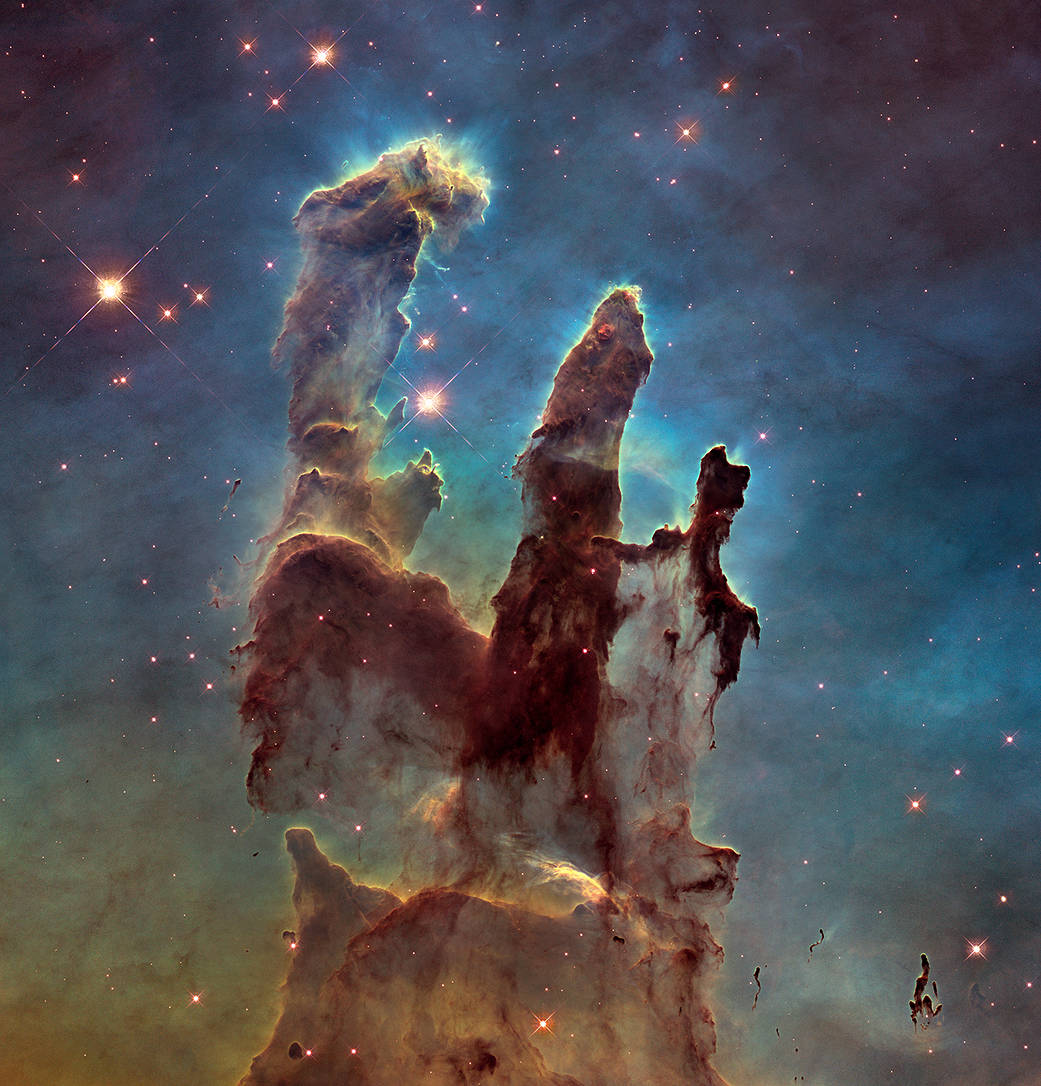
“Pillars of Creation” is a live view of stars forming in a neighboring region of the Milky Way. (Inside the Eagle Nebula, 5,400 to 6,100 light years away.)
The Solar System, formed 4.6 billion years ago. Earth became a planet .46 billion years later. That was 9.247 billion years after the Big Bang, which happened 13.787 billion years ago, meaning that our solar system is more than a third of the age of the Universe. (By the giant impact hypothesis, Earth was enlarged 4.5 billion years ago when it mooshed together with another planet about the size of Mars. That ex-planet is now called Theia, and the leftover material it scattered into space is now the Moon. Another gift to Earth, says the theory, is our water.)
Hydrogen, helium, and other light elements formed with the Big Bang, but the heavy elements were cooked up at various times in the 8 billion year span before our solar system was formed. Some, perhaps, are still cooking.
Life appeared on earth at least 3.5 billion years ago.* Oxygenation sufficient to support life as we know it happened at the start of proterozoic era, about 2.5 billion years ago. The phanerozoic eon, characterized by an abundance of plants and animals, began 0.541 billion years ago and will continue until the Sun gets so large and hot that photosynthesis as we know it becomes impossible. A rough consensus within science is that this will likely happen in just 600 million years, meaning we’re about 80% of our way through the time window for life on Earth.
More perspective: the primary rock formation on which most of Manhattan’s ranking skyscrapers repose—Manhattan Schist—is itself about a half billion years old. (My ass is three floors above some right now.)
In another 4.5 billion years, our galaxy, the Milky Way, will become one with Andromeda, which is currently 2.5 million light-years distant but headed our way on a collision course, looking for now like a thrown frisbee, four moons wide. (It’s actually much larger.) The two will begin merging (not colliding, because nearly all stars are too far apart for that) around 4 billion years from now, and in about 7 billion years will complete a new galaxy resembling an elliptical haze. Here is a video simulation of that future. And here are still panels for the same:

Our Sun will likely be around for all of that future, though by the end it will have become a red giant with a diameter wider than Earth’s orbit, or perhaps will have gone nova, surviving as a white dwarf. (Also—I’m adding this later—Andromeda is weird and scary.)
When that’s done, the Universe will be about 16 billion years old. Or young. In TIME WITHOUT END: PHYSICS AND BIOLOGY IN AN OPEN UNIVERSE, Freeman Dyson gives these estimates for the future age of the Universe:
TABLE I. Summary of time scales.
Closed Universe
Total duration 10^11 yrOpen Universe
Low-mass stars cool off 10^14 yr
Planets detached from stars 10^15 yr
Stars detached from galaxies 10^19 yr
Decay of orbits by gravitational radiation 10^20 yr
Decay of black holes by Hawking process 10^64 yr
Matter liquid at zero temperature 10^65 yr
All matter decays to iron 10^1500 yr
Collapse of ordinary matter to black hole
[alternative (ii)] 10^(10^26) yr
Collapse of stars to neutron stars
or black holes [alternative (iv)] 10^(10^76) yr
So the best guess here is that Universe is about 1% into its lifespan, which has a great many zeros in its number of birthdays. In biological terms, that means it’s not even a baby, or a fetus. It’s more like a zygote, or a blastula.
So maybe… just maybe… the forms of life we know on Earth are just early prototypes of what’s to come in the fullness of time, space, and evolving existence.
Bonus link: Katie Mack, who has forgotten more about all this than I’ll ever know.
[Later…] *Make that 4.1 billion years ago.
[Later again…] Then there is this.
Leave a Reply